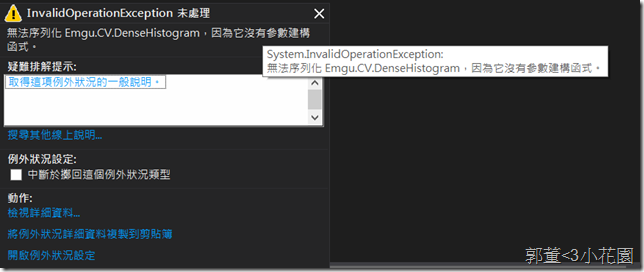在EmguCV中把直方圖相關資訊儲存成檔案,不像在OpenCV時有一些函式方法可以解決(Ex:CvOpenFileStorage、cvWrite...)。
EmguCV不好找 ,而且OpenCV相關個涵式在CvInvoke中也不齊全(Ex:cvWrite不存在),想使用C#的XmlSerializer,也會發現EmguCV的值方圖類別DenseHistogram不支援,好在後發現了一篇討論文找出了解決方法
前言
在EmguCV中把直方圖相關資訊儲存成檔案,不像在OpenCV時有一些函式方法可以解決(Ex:CvOpenFileStorage、cvWrite...)。
EmguCV不好找 ,而且OpenCV相關個涵式在CvInvoke中也不齊全(Ex:cvWrite不存在),想使用C#的XmlSerializer,也會發現EmguCV的值方圖類別DenseHistogram不支援,好在後發現了一篇討論文找出了解決方法
保存與讀取Histogram
在EmguCV中,計算與紀錄Histogram資料的方式主要都是透過DenseHistogram類別,但是EmguCV其實並沒有完整的所有OpenCV中的功能都包裝進來,有些可能也有Bug要待下一版處理
使用EmguCV 2.4.0時,不像在OpenCV時有完整可對應的函式方法可以解決
Ex:不法如透過CvOpenFileStorage與cvWrite和cvRead讀寫檔`,因為沒有cvWrite
後來自己透過extern並從openCV中的DLL找出對應匯入,使用cvWrite,卻又發現openCV中的方法:cvRead或cvReadByName會失敗…
最後發現DenseHistogram有支援序列化!
解決方式-使用BinaryFormatter序列化與反序列化
透過二位元序列化方式把整個資料Save至檔案或Load到DenseHistogram
記得加入
using System.Runtime.Serialization.Formatters.Binary;
Save存入檔案
private void SaveHistToBinaryFile(DenseHistogram histDense,string textFileName)
{
Stream stream;
System.Runtime.Serialization.Formatters.Binary.BinaryFormatter bformatter;
//寫檔
try
{
// serialize histogram
stream = File.Open(textFileName + ".bin", FileMode.Create);
bformatter = new System.Runtime.Serialization.Formatters.Binary.BinaryFormatter();
bformatter.Serialize(stream, histDense);
stream.Close();
}
catch (IOException ex)
{
throw new InvalidOperationException(ex.Message);
}
}
Load讀取檔案
private DenseHistogram LoadHistBinaryFile(string loadHistFileName) {
Stream stream;
System.Runtime.Serialization.Formatters.Binary.BinaryFormatter bformatter;
DenseHistogram histLoaded;
try
{
if (File.Exists(loadHistFileName))
{
stream = File.Open(loadHistFileName, FileMode.Open);
bformatter = new System.Runtime.Serialization.Formatters.Binary.BinaryFormatter();
histLoaded = (DenseHistogram)bformatter.Deserialize(stream);
stream.Close();
return histLoaded;
}
return null;
}
catch (IOException ex)
{
throw new InvalidOperationException(ex.Message);
}
}
解決方式-使用SoapFormatter序列化與反序列化
記得加入
using System.Runtime.Serialization.Formatters.Soap;
Save存入檔案
private void SaveHistToSOAPFile(DenseHistogram histDense, string textFileName)
{
Stream stream;
SoapFormatter soapformatter;
//寫檔
try
{
// serialize histogram
stream = File.Open(textFileName + ".soap", FileMode.Create);
soapformatter = new SoapFormatter();
soapformatter.Serialize(stream, histDense);
stream.Close();
}
catch (IOException ex)
{
throw new InvalidOperationException(ex.Message);
}
}
Load讀取檔案
private DenseHistogram LoadHistSOAPFile(string loadHistFileName)
{
Stream stream;
SoapFormatter soapformatter;
DenseHistogram histLoaded;
try
{
if (File.Exists(loadHistFileName))
{
stream = File.Open(loadHistFileName, FileMode.Open);
soapformatter = new SoapFormatter();
histLoaded = (DenseHistogram)soapformatter.Deserialize(stream);
stream.Close();
return histLoaded;
}
return null;
}
catch (IOException ex)
{
throw new InvalidOperationException(ex.Message);
}
}
至於使用XML序列化則會出現以下狀況
參考資料
文章中的敘述如有觀念不正確錯誤的部分,歡迎告知指正 謝謝 =)
另外要轉載請附上出處 感謝


